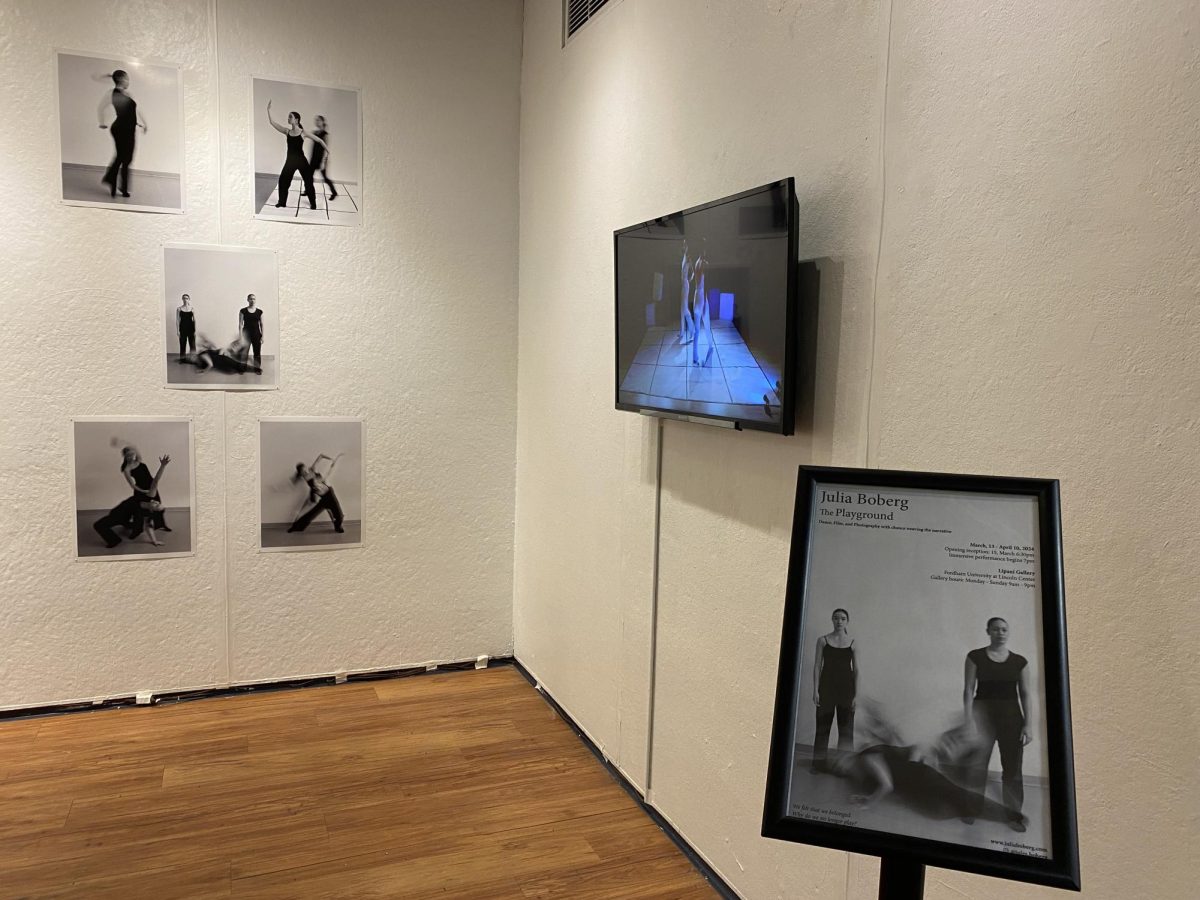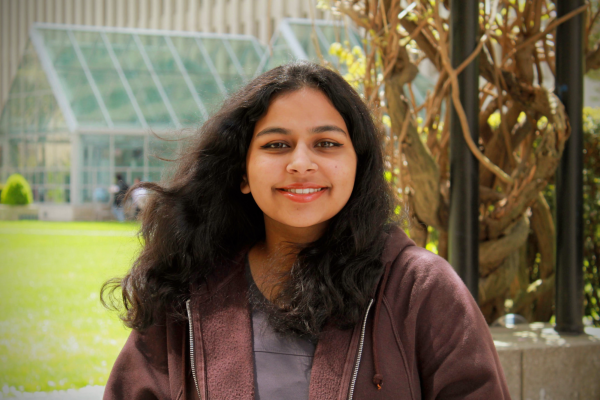New York-based poet Ama Birch gave a live performance of her spoken word album “Fresh Pond Road” as well as some poems from her collection “Remember the Mespeatches Who Resided at the Bad Water Place” on March 7 in Fordham Lincoln Center’s Lipani Gallery. Birch was accompanied by percussionist Ryan Sawyer and the event was the second installment of the gallery’s “Words & Sounds Series.”.
The poetry collection from Birch’s spoken word album consists of 19 list poems, each of which detail the storefronts and signs decorating Fresh Pond Road: a diagonal road in New York City’s largest borough, Queens, that stretches from Maspeth to Ridgewood.
The album recording of “Fresh Pond Road” has a melodic component and several production effects used on both the instruments and Birch’s voice. Birch mentioned that in past album performances, there have even been saxophone accompaniments which have provided a jazz-influenced backdrop.
I could almost picture her pointing at one side of the avenue before shouting to look over at the other side.
For this performance, however, she shared that she wanted to try a “high drum/low drum” dynamic to draw attention to the percussiveness and rhythm of her vocal delivery. Although she was aiming to be the higher-pitched drum in this duo, the sound of her voice thumping into the sensitive microphone produced a bass drum sound, transforming her voice into two drums simultaneously.
The duet between Birch and Sawyer was not rehearsed — this performance was their one and only take.
“I’m interested in phenomenology, and I’m interested in the aesthetics of free jazz and improvisation,” Birch said. “And so I don’t plan out where I’m going to inflect my voice as I move through my poetry. I let that happen with feeling, and I don’t expect to perform it the same way every time.”
The event was a small affair in the corner of the gallery with ambient pink, orange and blue lighting. Birch was seated on a stool front and center and Sawyer was nestled off to the side with nothing but a snare drum, hi-hat and a few auxiliary percussion instruments. It was a cozy, informal setting that placed the audience on almost the same level as Birch, suggesting a lighthearted, intimate conversation. The setting, however, was in stark contrast to the radical subject material of Birch’s poetry and the frenzied energy of Sawyer’s accompaniment.
The spoken word performance began with a pensive triangle roll heralding Birch’s introduction of the poem. Her deliberate vocal technique and pronunciation were immediately the most noticeable aspect of the recitation. She accented particular words and sounds for each avenue, sometimes in a subtly ironic manner. Having never heard Birch’s album before, I expected the recitation to be like a storytime event with a soft, dreamy voice. Rather, Birch spoke in powerful tones rivaling those of an auctioneer’s.
Sawyer’s music acted more in dialogue with Birch’s poetry as the two went back and forth in conversation.
Some transitions between poems were relatively smooth, whether that was due to a continuous percussive line under the words or the subject material flowing easily. Other transitions came as a total surprise, mirroring the stark contrast of avenues in New York City.
Each seemingly innocent snapshot was somehow interwoven with the effects of urban renewal, resulting in a harsh back-and-forth between the mundane aspects of life in New York and the systemic violence tightly-knit within its history. These grave moments were punctuated by a particularly droning, grating voice in juxtaposition to the almost sardonic voice used elsewhere in the performance.
The experience overall felt as if Birch was taking me by the hand and leading me on a walk down Fresh Pond Road as she painted a vivid picture of the signs surrounding us. I could almost picture her pointing at one side of the avenue before shouting to look over at the other side, wrenching my attention back and forth between the overwhelming storefronts. In a perfect compliment to Birch’s feverish recitation, Sawyer’s unrelenting hi-hat propelled me onward down each avenue even as I struggled to make sense of the surroundings that Birch was painting.
Despite the improvisatory nature of the performance, there were several moments of dialogue and imitation between the voice and snare, highlighting the conversational aspect of “Fresh Pond Road” with its musical accompaniment.
There was one particularly magical moment at the beginning of a phrase in which Sawyer hit the snare drum at precisely the same time that Birch spoke, providing the perfect example of Birch’s point to phenomenology and the creative coincidences that can happen in an unplanned setting. The performance concluded with a soft, ringing note on Sawyer’s triangle, tracing its cyclical arc in an implication that the recitation could start from the beginning all over again.
With his limited assortment of instruments and abounding creativity, Sawyer was able to produce several psychedelic timbres through various experimentative techniques, such as placing a cowbell on the snare drum to change its pitch and even turning the drum upside down to drag the sticks through the rattling snare wires themselves. His performance was a demonstration that it doesn’t take much to create an expansive textural environment. However, rather than providing a steady, unobtrusive backdrop, Sawyer’s music acted more in dialogue with Birch’s poetry as the two went back and forth in conversation, one sometimes overtaking the other in volume and urgency.
While the poems are certainly able to stand on their own, I would argue that “Fresh Pond Road” is not a collection that requires accompaniment. It is one side of a dialogue requiring a partner. Birch’s poems act as questions and the music is an improvisatory, provocative response representing just one point of view in a much larger conversation.
This event was sponsored by the Visual Arts Department with support from The Center for Community Engaged Learning.


